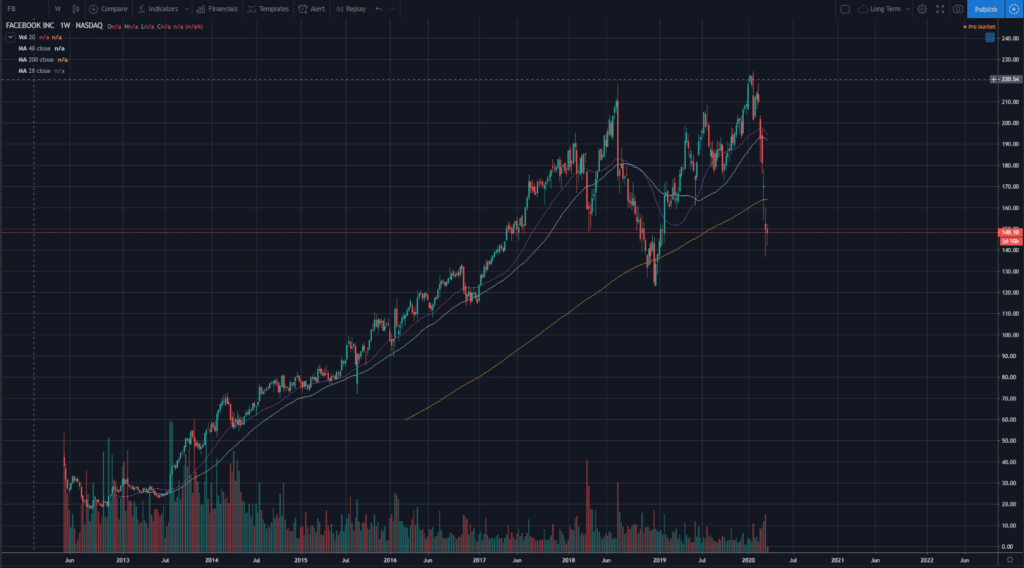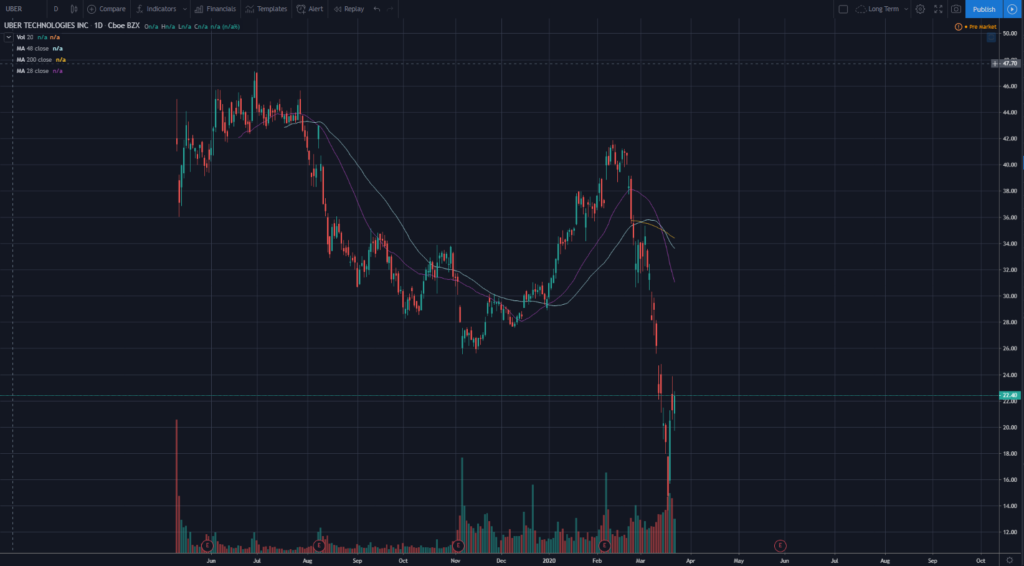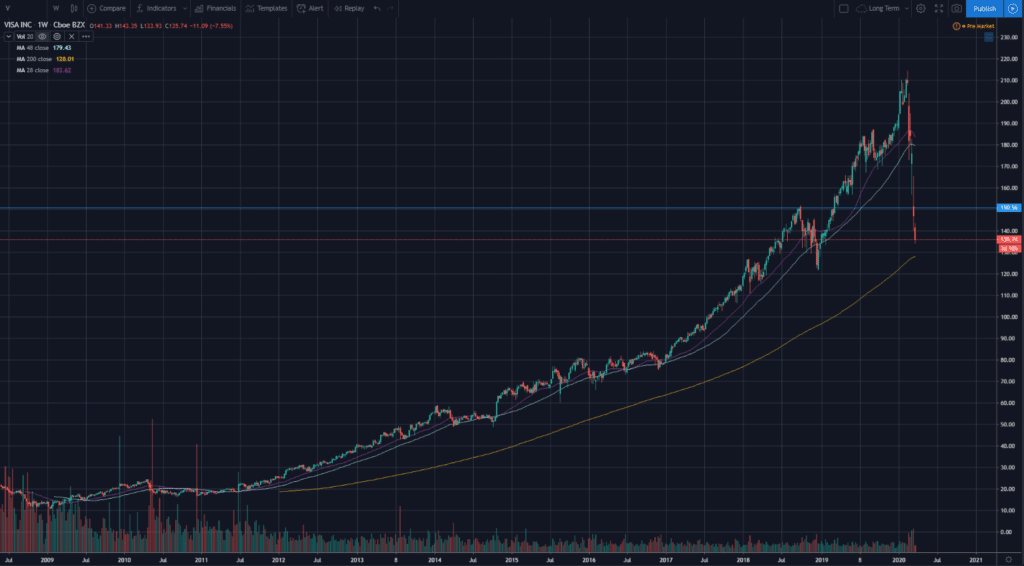Table of Contents
15 minute read
We get this question all the time.
“What stocks should I buy?”
“TMF, what stocks to buy??”
Let’s settle this.
Over the past month or so, stocks globally have entered the dreaded bear territory, falling more than 20% since their peaks in February.
All over the world, people can’t stomach opening their accounts to check on their stock portfolio.
Our StashAway accounts have also been hit hard, dropping more than 30% as of the 24th of March.
Thankfully, we haven’t yet started building our stock portfolio.
Most of our assets were in cash, StashAway, & Amanah Saham.
As mentioned in previous articles, we think this is an amazing opportunity for us to start building up our stock portfolio.
Stocks are at bargains right now.
Fresh from all time highs, many stocks have been getting humbled by the power of the market, falling back to 2017 levels.
Is this the bottom?
We don’t know, it’s probably not.
No one knows where the bottom is though, which is why we’ve decided to take the approach of entering positions in batches.
So what are the stocks to buy?
Before we begin, we want to make it clear that everything in this article should NOT be taken as financial advice.
Just because we bought the stocks, doesn’t mean you should.
And just because we chose these stocks to buy doesn’t mean it will do well for you.
We always encourage our readers that while getting to know the opinion of others can be helpful, do your own research before making a decision.
Now let’s start!
So far, we’ve added 3 stocks to buy that we really like into our portfolios with small positions.
Stocks To Buy (Personal Opinion)
1. Facebook

Buy Price: $149

The first company that made it into our stock portfolio is Facebook.
They’re one of 2 companies nearly monopolizing the digital advertising market, with the other being Google.
The company has grown its revenue from $1.27B in 2015 to $4.71B last year, a tremendous 271% growth.
Pandemic Impact
Since the start of the crisis, shares of the company have dropped from $220 to its current price of $148, representing a 33% decline which is in line with the market.
In the short-term, lower advertising spend especially by small & medium businesses will definitely have some negative impact on Facebook.
Currently, 98.5% of their revenue is from their advertising prowess.
However, we feel that an increased audience and a shift towards e-commerce/digital marketing will help offset some of this impact as more merchants start to see the value of having an online presence.
Once everything is over, we expect Facebook’s recovery to be quick as merchants fight for market share.
It’ll almost seem like starting everything from scratch for some industries so getting customers in will be crucial.
To add icing on the cake, Facebook has an extremely strong balance sheet.
Their cash position alone is enough to pay off ALL debts, meaning the chance of going bust is virtually zero.

Long term outlook
We’re gonna be honest, Facebook isn’t the first app we open when I’m looking to chill out and scroll through feeds.
Within our circle of friends in Malaysia at least, Facebook seems to have somewhat lost its spark. But friends from other countries still use Facebook heavily.
As of December 2019, they boast 2.5 billion monthly active users, representing roughly 1/3rd of the global population.
Aside from the Facebook app, many of you probably know that they also own Instagram.
Now this is something along our alley.
In 2012, Facebook acquired Instagram for only $1 billion, proving to be one of the most astute pieces of business to date. In 2014, they also bought WhatsApp for $19 billion.
Shameless plug: Follow us on Instagram!
Whilst they haven’t quite figured out monetization on WhatsApp, Instagram’s popularity to advertisers is picking up some steam.
They’re already looking at ad monetization on their recently launched IGTV, which will be another stream of income.
There are also plans to roll out Instagram checkouts globally. This means that merchants can start selling their products directly on Instagram!
Now, we’re not gonna ignore the fact that Facebook is facing regulatory issues such as their role in Cambridge Analytica.
Still, we have faith in their management team to overcome this as they’ll realize the increasing demand for privacy and its impact on their profits.
For these reasons, Facebook gets the honour of kicking off our stock portfolio and being #1 on the list of stocks to buy.
2. Uber

Buy price: $21.50

OK, Uber is a bit of a risky one.
Being the first mover in a now wildly popular ride-hailing industry, Uber has seen their position being challenged in many countries across the globe.
They’ve managed to grow revenues by more than 3 fold from $3.85B in 2016 to $14.15B in 2019.
Although they haven’t turned profitable, they expect to do so by the end of 2020.
Looking at their financial report, it’s also encouraging to see that they’ve spent nearly $5 billion on research & development in 2019, up from just $864m in 2016.
Pandemic Impact
In the past month, Uber stock has seen their positive earnings reports from Q3 & Q4 last year completely wiped out and more by the pandemic.
Currently, they’re trading just above half of what they were valued at in February.
In the short term, Uber’s ride-sharing business should definitely take a hit.
Airport rides contribute to around 15% of their ride-hailing revenue, and it looks like that’s gonna be ruled out for as long as this continues.
We see 2 potential measures that could offset this though.
First, those who need to go out but don’t have a vehicle would probably rather get an Uber over taking public transport.
Lyft, another ride-hailing company in the US recently reported their highest ever revenue in a single week.
While Uber reported nothing of the likes, it’s interesting to see how much this could potentially offset softening organic demand.
Second, Uber also has a food delivery business named UberEats.
When everyone’s locked up at home, demand for home delivered food will definitely see a spike.
A food delivery company named Blue Apron has seen it’s valuation increase by 6x since the start of the pandemic.
Currently, UberEats only contributes 17% of the company’s total revenues, but we should keep an eye out on how much this percentage goes up in their next quarterly earnings.
We surely expect this to be significant, which will help in covering for short term weakness in ride hailing demand.

Long term outlook
There’s certainly room for growth for the ride hailing industry in the years to come.
Uber has presence in around 70 countries, many of which still have potential through the continued rise in mobile penetration and increasing middle class group.
Let’s zoom in on their bigger and more exciting bet though: driver-less cars.
Uber has poured a lot of money into this venture and their self-driving business alone is valued at $7 billion by investors.
Uber realizes this is a big opportunity. In their company alone, they’ve allocated 1,500 people to work on this project.
In 2019, Uber’s difference between gross bookings (how much customers pay) and revenues (how much Uber gets) was $50 billion.
This is what goes to their drivers, where Uber takes a cut of around 20-25% of all trips booked.
McKinsey expects driverless cars to be on the road as soon as in 3 years, but it’s expected to be done in phases.
Once things get up and running, companies like Uber are able to remove their reliance on drivers, getting the entire pie of customers wallets.
In our opinion, Uber’s business model will shift regardless of who manages to develop it first.
Even if companies like Tesla wins this race, Uber can simply ride on their technology & vehicles and roll it out as Uber branded cars.
It’s just a matter of getting regulatory approval in time before running out of cash to continue operating.
Again, this is one of our riskier investments.
Uber’s valuation of less than $40 billion proved too attractive for us to pass up on, so it’s a bet I’m willing to take.
It’s a high risk, high reward play and if everything works out, the sky’s the limit for Uber which could well be the next tenbagger.
A big contributor to why we’re betting on Uber in our stock portfolio at this time is that they have $10 billion in unrestricted cash, which will help them weather this storm.
As most of their costs are variable (dependent on revenue), this will most likely ensure their business makes it through.
That puts Uber as #2 on our list of stocks to buy.
3. Visa

Buy Price: $137.4

Despite Visa being a well known brand to everyone, not many people actually know what they do.
They don’t give out loans, they don’t store money, and they don’t provide credit cards.
Along with Mastercard & American Express, Visa is actually a payment processing company.
They connect customers, banks, & merchants to allow for the transaction and settlement of purchases.
Wait a second, this sounds like a boring company. Why put this in our list of stocks to buy…
Over the last 3 years, Visa has averaged a revenue increase of 15% annually.
Due to the nature of their business, they have a net profit margin of 50%, which is incredible.
Pandemic Impact
Visa’s shares have fallen 37% from their all-time highs of $214 to $136 currently.
Looking back at it, we could’ve probably held out for a better price.
Since their revenue is entirely driven by taking a fee from every purchase they facilitate, this decrease in consumption will take its toll on the company’s revenues.
When people spend less on their cards, Visa loses.
A glimmer of hope (barely) is that due to the outbreak, online spending has increased.
When we buy online, we tend to use debit/credit cards which would hopefully mitigate some impact.
We predict that once everything passes by, many people will start going ham on pent up urges to spend.
That’s how we feel anyway (please don’t expose us!).
Unlike other companies, Visa’s recovery should be incredibly fast as there’s no need to persuade customers to use their products.
When people spend, Visa wins.

Long term outlook
We’re not gonna sit here and pretend Visa is our favourite brand and go on about how much we love their product.
The truth is, Visa’s role in their ecosystem is silent but crucial.
They’re an enabler towards a cashless society… and we’re a big fan of that.
We hate using cash.
As much as we can, we’d always opt for a cashless payments which means using our credit card.
Nearly 80% of our monthly spending is on our credit card, meaning Visa is making money.
Here’s the exciting part.
85% of the global population still make transactions using cash, meaning there’s a long way to go in terms of growth.
Even if half of them decide to switch over in the next few years, Visa’s addressable market triples. Imagine that.
The reason we chose Visa over the other 2 is because they’re the leader in the industry right now.
They’re always one step ahead of their competition.
When Samsung Pay just launched, only Visa cards were accepted.
Their desire to innovate coupled with market share gives them the upper hand in new product launches, giving the feel of exclusivity.
Because of that, Visa gets a spot #3 on our list of stocks to buy.
If you haven’t noticed, our stock portfolio is tiny.
But those are what we think are the stocks to buy right now.
We’re gonna be taking our own advice (for once) and save as much as we can to build it up.
It’s a great opportunity we don’t wanna miss out on.
If you enjoyed reading this article about stocks to buy, do give us a shout out on your social media pages! (We even have nice shiny icons at the bottom).
We’d really appreciate it 🙂
Here are some related articles you can read to find out more about investing:


2 thoughts on “What Stocks To Buy? 3 Companies We’ve Added In Our Stock Portfolio”